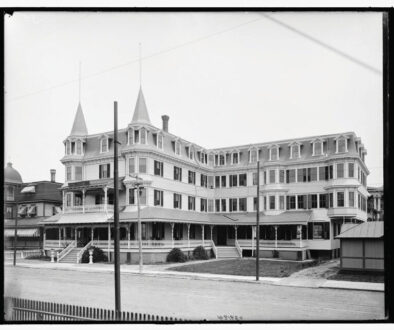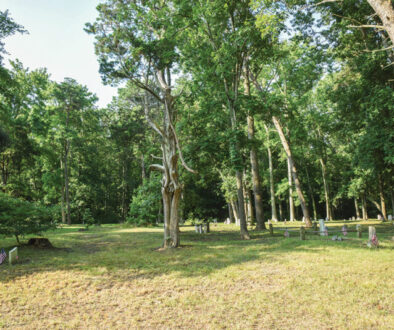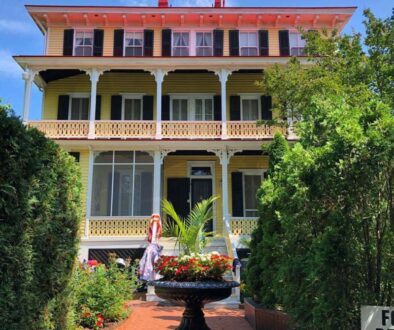Cape May As I Remember It: Part Five
Schellenger’s Landing is the area between Cape May Canal and the small bridge entering Cape May. In the 1930s, that bridge was a drawbridge. The boats that were docked on the northwest side of Route 9—now Route 109—had to use the drawbridge in order to reach the Atlantic Ocean via Cape May Harbor. The canal was not constructed at that time. When the waterway behind the Miss Chris fleet was dredged to the canal after it was constructed, the boats in that area used this waterway, and the drawbridge was converted to a fixed span.
Leaving Cape May via the small bridge, turn left onto Wilson Drive and there is a large metal building on the right. In the 1930s, Tony Cirrincione built wooden commercial boats in this building. Launch day was a big affair. There was a boat ramp opposite the metal building, and the boat was pushed across Wilson Drive to the ramp, and eventually into the water. There was a fisherman on the boat when it was launched. His job was to tie a line that was secured from the dock to the boat. If he didn’t, the boat would float across the waterway into Roseman’s Marina. I saw several boats being launched. It was always interesting and exciting.

Continuing on Wilson Drive, there were only boat houses from there. Condos were unknown in those days. There were many party boats where the Miss Chris boats are now located. I remember the Queen City, Comanche, Irma B, Mayflower, and others whose names I cannot recall. Andy Johnson packed fish from the commercial boats at the same dock. I worked on the dock for him a number of times. The pay was 75 cents an hour. If you worked hard he would give you several additional dollars. Andy was what I would call a “good guy.”
The Lucky Bones restaurant was called The Anchorage, and was owned by George Wallace in the 1930s. Next to it was a small store owned by the Lembergs. I delivered the evening Philadelphia Bulletin to them.
The canal was built in 1943, and several houses on Route 9 (now 109) were demolished or moved to make room for the canal. There was a wood bridge constructed over the canal at this time. You can see the remains of the old Route 9 leading to the canal when you cross the new bridge. Ocean Drive was constructed in the 1930s as a scenic route, from 109 through the Wildwoods, Stone Harbor, Avalon, and Sea Isle to Atlantic County. Ocean Drive was originally called Seagull Drive. There were signs along Seagull Drive with a picture of a seagull in flight. The name was later changed to Ocean Drive and the signs were removed.
Tony’s Marine Supply building was originally a Chevrolet dealership called Simpkins Chevrolet. The gasoline station located next to Simpkins was a one-room station that sold Gulf gasoline. There is a larger gas station at this location now.
Cold Spring Dock is where I spent many days while growing up. There were numerous party boats docked where the Lobster House is. These boats were the Captain Johnson, Ralph J, Angler, Osric, Black Gold (this was my dad’s boat), Gloria, Jackie B, Goose, and the Laura B. The fishermen’s train arrived at the dock every morning at 7:45. The fishermen would run from the train to get a good seat on their favorite boat. The train tracks had a bend in them before the train reached Route 9, and I was able to count the cars. My job was to climb to the roof of the ice house on the dock and call out the number of cars on the trains to the boat captains below. Thursday was a good day because the fish had to be caught for Friday’s dinner.
There is a small area between Jim’s Bait and Tackle and Lucky Bones where the train crossed Route 9. There was a lot of excitement at this time of the morning to see the fishermen running to the boats, and to see the boats racing to be the first to reach the fishing grounds. In those days, there were no insulated coolers to hold whatever the fishermen were bringing to eat. They carried their lunch in a shoebox. The word “shoobie” originated from the shoebox lunch. Cold drinks were available on the boats.

There were two train tracks that ran to Cold Spring Dock past the Lobster House. One track was for the fishermen’s special and the other for the freight cars to transport the fresh fish to Camden or Philadelphia. These freight cars were not refrigerated as they are today. Large pieces of ice were dropped into compartments at the end of the car and it was sufficient to keep the fish cool enough until it reached its destination.
There was an ice house on Cold Spring dock that made 300-pound cakes of ice. When the ice was frozen, the cakes were moved to the storage area where they remained until needed. We boys had the run of the dock because we were no trouble, kept out of the way when fish was being unloaded, and we knew the dock workers. I liked to be there when the party boats returned so we could see the fish they caught. As I said before, my dad had a party boat, and I liked to be there when he returned.
Years ago during the early spring, there was a large number of boats fishing the East Coast for mackerel. The boats were from New England, in the Gloucester, Massachusetts area. They would start south of Cape May and continue up the coast, following the mackerel. When they reached New Jersey, their port of call was Cape May. They unloaded their fish at Cold Spring Dock. It was a very busy time. There were many boats at Cold Spring Dock, more than you see moored there now. I became acquainted with some of the men because they returned year after year. Mackerel are a cold-water fish, and the boats followed them to Nova Scotia and beyond. It will be a long time—if ever—to see the mackerel fleet in Cape May again.

Before the Lobster House was constructed, there was a small restaurant and bar in that location. It was run by Charlie Bateman, whose specialty was oyster stew for 25 cents. The fishermen enjoyed it when they returned from fishing. There is a large photo in the vestibule when you enter the Lobster House that shows this restaurant and all the party boats from all the other docks. The photo was taken in 1935 by Atlantic Studios, and I am in that photo. I’m sitting on a piling next to my brother in front of the boat Black Gold.
Tony’s Railway is still there today, as it was in the 1930s. Next to the railways is the South Jersey Marina, with a considerable number of sport fishing boats. In the 1930s, there was no marina—only boat houses. The marina area as you see it today was only marsh in the 1930s. When we crossed the marsh—and by “we” I mean Larry Mears and myself—there were many fiddler crabs looking for a burrow to climb into. The marsh was eventually dredged, docks were installed, and it was named Scotties after I. Grant Scott.
Schellengers Landing hasn’t changed that much since the 1930s, except that trucks have replaced the trains, bigger and better cars are the primary mode of transportation for the fishermen, and the $2.00 ticket for fishing has increased to $60 or more.
Larry Mears and Peggy Ladd contributed to this article.



